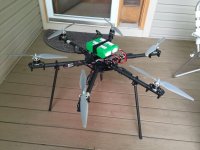crayfellow
Member
Inline with @SchrodingersCar 's 'Humbled' thread, I'm struggling with the basics of getting a 1000mm-ish craft in the air.
I'm now pretty comfortable flying a 250-class quad (Blackout mini H with a nice FPV setup), and a FliteTest Electrohub wooden tricopter. I started with the 250 and cc3d so I wouldn't get distracted with fancy GPS, alt-hold, or any of that. Also built a Pixhawk rover to get used to its capabilities. Moved on last Sunday to building the tri (APC 9x4.5 MR, X2212 KV980, 30A Lumenier ESC, Pixhawk, telemetry, M8N GPS, FrSky X8R, simple 250mW vtx and cam) to try out Pixhawk in the air. My 7 year old son was able to fly it (with supervision in a big field) thanks to Loiter mode!
All along my plan has been to build a larger hex as a research platform for various experiments into applications of sUAS. Here's the setup:
Upon the first step, the poor thing promptly flipped to the left and broke its GPS mast. So I pulled it out, stuck in what was left, tightened the set screw, and went back to reading.
I am well aware there are specific things one must do to get KDE ESC's happy with Pixhawk. I had gone through the "all at once" Pixhawk ESC calibration. I'm not sure whether setting RCx_MIN to 1100 and RCx_MAX to 1900us should happen before or after ESC calibration. It seems like after I adjusted the MIN and MAX the props spun upon arm, but then seemed to spin up much faster upon throttle. So then I did another ESC calibration, and they no longer spun when armed, but I double checked and my 1100 and 1900 numbers were still there.
Anyway, I tried 3-4 more times after reading I might try another accelerometer calibration, tried fiddling with the roll/pitch with little throttle bursts to make sure it was even orientated properly (it seemed to be), but all of this culminated in 3-4 more flips. The final flip broke a prop so I'm clearly missing a few things.
I am using 450mm legs, and especially with no payload, am I just asking too much for it to happily pop in the air with little to no pitch/roll intervention like the mini or tri? This guy's payload is an InfinityMR gimbal, which is all set to go, but I'm obviously going to make sure the rig is happy before bolting that on for flight. I know I should have some weight in the place of the gimbal; is that in fact mandatory?
Would I be better off switching to shorter legs (I have some 315mm), and adding some weight, or would it still be so tricky to get this guy in the air?
Any other thoughts?
View attachment 25519
I'm now pretty comfortable flying a 250-class quad (Blackout mini H with a nice FPV setup), and a FliteTest Electrohub wooden tricopter. I started with the 250 and cc3d so I wouldn't get distracted with fancy GPS, alt-hold, or any of that. Also built a Pixhawk rover to get used to its capabilities. Moved on last Sunday to building the tri (APC 9x4.5 MR, X2212 KV980, 30A Lumenier ESC, Pixhawk, telemetry, M8N GPS, FrSky X8R, simple 250mW vtx and cam) to try out Pixhawk in the air. My 7 year old son was able to fly it (with supervision in a big field) thanks to Loiter mode!
All along my plan has been to build a larger hex as a research platform for various experiments into applications of sUAS. Here's the setup:
- QuadFrame foldable pro SIXcopter frame with aerialpixels M325 motor mounts
- KDE 3520 400kv motors
- KDE 55A ESC's
- APC 15x5.5 MR props
- FrSky X8R
- Flytron strobon NEO LED strips x 4
- Pixhawk with telemetry and attopilot 180A voltage/current sensing
- 5V 2.5A pololu regulator to power Pixhawk (in place of the 3DR power module since I am using attopilot and 6S)
- 5V 2.5A pololu regulator to power servo rail (KDE opto isolators, rx, and LED's)
Upon the first step, the poor thing promptly flipped to the left and broke its GPS mast. So I pulled it out, stuck in what was left, tightened the set screw, and went back to reading.
I am well aware there are specific things one must do to get KDE ESC's happy with Pixhawk. I had gone through the "all at once" Pixhawk ESC calibration. I'm not sure whether setting RCx_MIN to 1100 and RCx_MAX to 1900us should happen before or after ESC calibration. It seems like after I adjusted the MIN and MAX the props spun upon arm, but then seemed to spin up much faster upon throttle. So then I did another ESC calibration, and they no longer spun when armed, but I double checked and my 1100 and 1900 numbers were still there.
Anyway, I tried 3-4 more times after reading I might try another accelerometer calibration, tried fiddling with the roll/pitch with little throttle bursts to make sure it was even orientated properly (it seemed to be), but all of this culminated in 3-4 more flips. The final flip broke a prop so I'm clearly missing a few things.
I am using 450mm legs, and especially with no payload, am I just asking too much for it to happily pop in the air with little to no pitch/roll intervention like the mini or tri? This guy's payload is an InfinityMR gimbal, which is all set to go, but I'm obviously going to make sure the rig is happy before bolting that on for flight. I know I should have some weight in the place of the gimbal; is that in fact mandatory?
Would I be better off switching to shorter legs (I have some 315mm), and adding some weight, or would it still be so tricky to get this guy in the air?
Any other thoughts?
View attachment 25519


